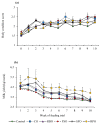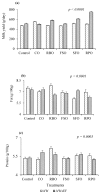Supplementing Dairy Ewes Grazing Low Quality Pastures with Plant-Derived and Rumen-Protected Oils Containing Eicosapentaenoic Acid and Docosahexaenoic Acid Pellets Increases Body Condition Score and Milk, Fat, and Protein Yields
- PMID: 30572585
- PMCID: PMC6316841
- DOI: 10.3390/ani8120241
Supplementing Dairy Ewes Grazing Low Quality Pastures with Plant-Derived and Rumen-Protected Oils Containing Eicosapentaenoic Acid and Docosahexaenoic Acid Pellets Increases Body Condition Score and Milk, Fat, and Protein Yields
Abstract
The Australian dairy sheep industry is small and mostly based on a natural grass grazing system, which can limit productivity. The current study tested different plant oil-infused and rumen protected polyunsaturated fats and their interactions with sire breeds to improve lactation traits and body condition scores (BCS) of ewes grazing low quality pastures. It was hypothesised that supplementing lactating ewe's diets with plant-derived polyunsaturated oils would improve milk production and composition without compromising BCS. Sixty ewes (n = 10/treatment) in mid-lactation, balanced by sire breed, parity, milk yield, body condition score, and liveweight, were supplemented with: (1) control: wheat-based pellets without oil inclusion; wheat-based pellets including; (2) canola oil (CO); (3) rice bran oil (RBO); (4) flaxseed oil (FSO); (5); safflower oil (SFO); and (6) rumen protected marine oil containing eicosapentaenoic acid and docosahexaenoic acid (RPO). Except for the control group, all supplementary diets included the same level of 50 mL/kg DM of oil and all diets were isocaloric and isonitrogenous. Experimental animals were grazed in the same paddock with ad libitum access to pasture, hay, and water during the 10-week study. RPO was the most effective diet that enhanced milk, fat, and protein yields by approximately 30%, 13%, and 31%, respectively (p < 0.0001). A significant increase in milk production was also observed with CO, RBO, and SFO treatments (p < 0.0001). Breed significantly influenced animal performance with higher milk yields recorded for crossbred Awassi × East Friesian (AW × EF) (578 g/day) vs. purebred Awassi (452 g/day) (p < 0.0001). This study provides empirical evidence for the use of rumen-protected and plant-derived oil-infused pellets as supplements under low quality pasture grazing conditions to improve the production performance of purebred Awassi and crossbred AW × EF ewes.
Keywords: PUFA; body condition score; canola; flaxseed; oils; rice bran; safflower; sheep milk composition; supplementation.
Conflict of interest statement
The authors declare no conflict of interest. The funders had no role in the design of the study; collection, analyses, or interpretation of data; in the writing of the manuscript, or in the decision to publish the results.
Figures



Similar articles
-
Enhancement of dairy sheep cheese eating quality with increased n-3 long-chain polyunsaturated fatty acids.J Dairy Sci. 2019 Jan;102(1):211-222. doi: 10.3168/jds.2018-15215. Epub 2018 Nov 1. J Dairy Sci. 2019. PMID: 30391173
-
Nutritional Supplements Fortified with Oils from Canola, Flaxseed, Safflower and Rice Bran Improve Feedlot Performance and Carcass Characteristics of Australian Prime Lambs.Animals (Basel). 2018 Dec 5;8(12):231. doi: 10.3390/ani8120231. Animals (Basel). 2018. PMID: 30563070 Free PMC article.
-
Effect of rumen-undegradable protein supplementation and fresh forage composition on nitrogen utilization of dairy ewes.J Dairy Sci. 2011 Jan;94(1):416-25. doi: 10.3168/jds.2010-3656. J Dairy Sci. 2011. PMID: 21183052 Clinical Trial.
-
Effect of cassava hay and rice bran oil supplementation on rumen fermentation, milk yield and milk composition in lactating dairy cows.Asian-Australas J Anim Sci. 2012 Oct;25(10):1364-73. doi: 10.5713/ajas.2012.12051. Asian-Australas J Anim Sci. 2012. PMID: 25049491 Free PMC article.
-
Dairy sheep production research at the University of Wisconsin-Madison, USA - a review.J Anim Sci Biotechnol. 2014 Apr 16;5(1):22. doi: 10.1186/2049-1891-5-22. eCollection 2014. J Anim Sci Biotechnol. 2014. PMID: 24739956 Free PMC article. Review.
Cited by
-
Discrepancies in the rumen microbiome, metabolome, and serum metabolome among Hu sheep, East Friesian sheep, and East Friesian × Hu crossbred sheep.Front Microbiol. 2025 Apr 28;16:1498050. doi: 10.3389/fmicb.2025.1498050. eCollection 2025. Front Microbiol. 2025. PMID: 40356639 Free PMC article.
-
Next Generation Sequencing of Single Nucleotide Polymorphic DNA-Markers in Selecting for Intramuscular Fat, Fat Melting Point, Omega-3 Long-Chain Polyunsaturated Fatty Acids and Meat Eating Quality in Tattykeel Australian White MARGRA Lamb.Foods. 2021 Sep 27;10(10):2288. doi: 10.3390/foods10102288. Foods. 2021. PMID: 34681337 Free PMC article.
-
Microencapsulation technology for delivery of enzymes in ruminant feed.Front Vet Sci. 2024 Jul 12;11:1352375. doi: 10.3389/fvets.2024.1352375. eCollection 2024. Front Vet Sci. 2024. PMID: 39071783 Free PMC article. Review.
-
Feeding and Nutritional Factors That Affect Somatic Cell Counts in Milk of Sheep and Goats.Vet Sci. 2023 Jul 11;10(7):454. doi: 10.3390/vetsci10070454. Vet Sci. 2023. PMID: 37505859 Free PMC article. Review.
References
-
- Park Y.W., Juarez M., Ramos M., Haenlein G.F.W. Physico-chemical characteristics of goat and sheep milk. Small Rumin. Res. 2007;68:88–113. doi: 10.1016/j.smallrumres.2006.09.013. - DOI
-
- AgriFutures Australia Dairy Sheep. [(accessed on 31 April 2018)];2013 Available online: https://www.agrifutures.com.au/farm-diversity/dairy-sheep/
-
- Dairy Australia Milk. [(accessed on 31 April 2018)];2018 Available online: https://www.dairyaustralia.com.au/industry/production-and-sales/milk.
-
- Abd Allah M., Abass S., Allam F.M. Factors affecting the milk yield and composition of Rahmani and Chios sheep. Int. J. Livest. Prod. 2011;2:24–30.
LinkOut - more resources
Full Text Sources

